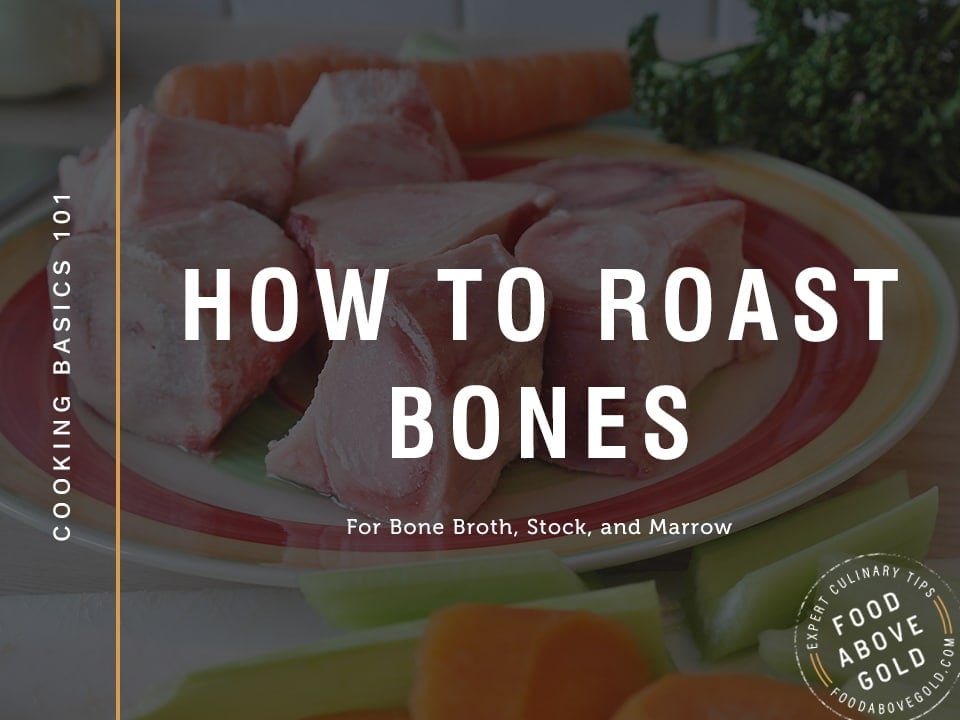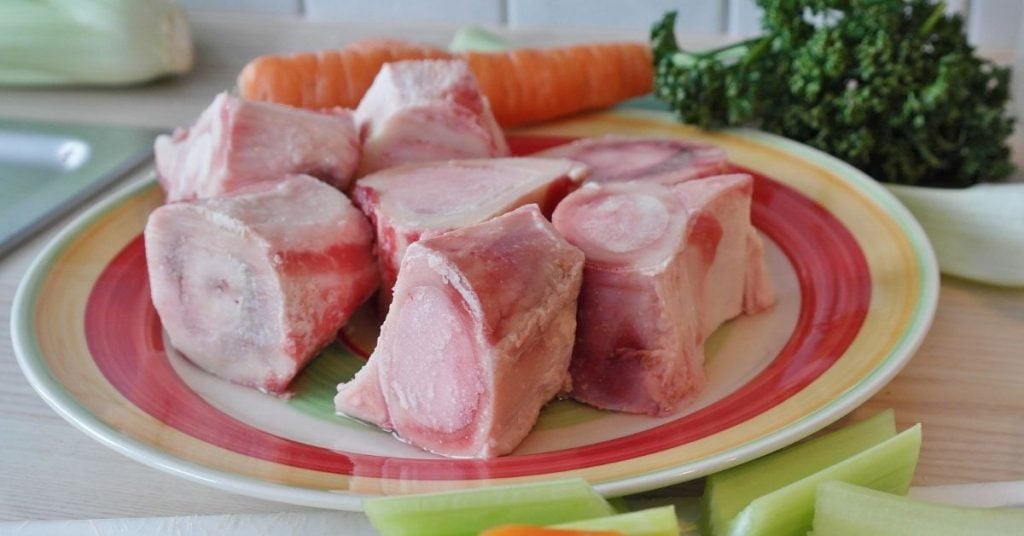Whether you’re making a bone broth recipe, homemade stock, or want to try eating bone marrow, properly roasted bones are important for quality. Find out the benefits of roasting bones and how to roast bones for each type of use!

This post was updated on July 1, 2019 with new content for your enjoyment.
As we begin looking at the different building blocks of sauces, let’s focus on how to roast bones. This is great if you want to take up drinking bone broth, want to make a thick and rich brown stock, or you want to start eating health-promoting marrow.
What Are The Benefits of Roasting Bones?
There are many different reasons for roasting bones, both for your stock/broth and for your health.
- Stock and/or Bone Broth Benefits
- Flavor. Roasting your bones helps to create a deeper, fuller, and richer flavor from the caramelizing of the meat and marrow.
- Gelatin. The naturally existing collagen and connective tissue in the bones helps make your stock thick and gelatinous. When you add acid to your bones (usually from brushing them with tomato paste) it helps to draw out even more of the collagen to make an even thicker stock. This is great if you plan to reduce it into a demi-glace.
- Nutrients. As the bones are boiled into the bone broth or stock, it melts in the marrow; this may release many of the marrow's health benefits (although this is up for debate as there isn't a lot of scientific backing for it. If you would like to read more, check out this article from NPR).
- Health
- The marrow in bones is not just for food snobs or your dogs; it is packed with lots of quality vitamins and minerals, stem cells, and amino acids.
- Marrow is believed to reduce inflammation (especially in the GI tract), promote self-healing, improved brain function, healthy skin, and help prevent and/or heal cancer.
- Marrow is high in healthy fats and is good for promoting a longer lasting "full" feeling after eating.
Not all bones are equal! Knowing how to roast bones properly can maximize the health benefits. It's also important to choose bones that have a higher amount of marrow and are from animals that are raised humanely and organically.

How To Roast Bones for Bone Broth or Stock
Properly roasted bones give additional flavor and body to your bone broth or stock. If I could give you my number one trick for success, it is this!
- Preheat your oven to 425°F.
- Place bones in a heavy bottomed deep roasting pan, or on a parchment paper lined baking sheet and roast in the oven for about 30 minutes. You want the bones to be a darker color but not burn any residual meat.
- If desired: remove the bones from the oven, brush them with tomato paste and return them to the oven for an additional 10 minutes.*
*The acid in the tomato paste helps dissolve the connective tissue in the bones. It also adds a little extra flavor.
How to Roast Bones for Marrow
When it comes to eating marrow, the best bones for the job come from beef or veal. You can get marrow bones pretty easily from your butcher (and usually very cheap) and they can leave them whole or cut them in half. Either will work wonderfully, but if you get the split bones your cooking time may vary depending on how thick they are. However, this does make it easier to get the marrow out
You want your marrow to be loose and give a little, but make sure to remove it from the oven before it begins to cook away.
- Preheat oven to 450 degrees.
- Place your bones vertically on a parchment paper lined sheet pan and sprinkle them lightly with salt.
- Place in the oven and roast for 15 minutes.
- Remove the bones from the oven and scoop out the marrow using a spoon or butter knife.
- Serve as desired: on grilled bread, in a compound butter, with garlic and caramelized onions, with parsley and lemon, straight out of the bone - whatever strikes your fancy.
Practice Makes Perfect
Now that you know how to roast bones, put it to good use. Here are some recipes I recommend trying:
- Rich & Flavorful Brown Stock (This works for beef stock, chicken broth, etc...)
- Espagnole Mother Sauce
Thanks for stopping by!
Happy Cooking! 🙂



Cynthia says
p.s. Also, after I roast the bones, should I wait a while before I put it in the slow cooker with the vinegar or wine and the other ingredients? Do the bones need to cool off?
Thank you very much!
Cynthia (again)
Mackenzie Ryan says
Great questions! You should be fine to put it right into the slow cooker, no need to cool! 🙂
Cynthia says
Hi Mackenzie,
Thanks for the great tips. I'm cooking my bone broth in a slow cooker. Recipes call for 24, 48 and even 72 hours. Do you have any recommendations on how long I should slow cook the bones?
Thank you,
Cynthia
Mackenzie Ryan says
Hi Cynthia! 24 hours should be fine! Once the marrow has come out of the bones and dissolves into the broth, the only reason to keep it cooking is to concentrate it for texture or flavor. Continuing to cook bone broth beyond that won't really give you any benefits or additives. I hope that helps!
Nicole says
What exactly drips from the bones after roasting? Is it fat? I always have a pan full of oil type substance that hardens/whitens when cooled so I’m assuming it’s fat? I never know if I should add it to the stock?
Mackenzie Ryan says
Hi Nicole,
Great question! The stuff that drips off the bones is a combination of fat, overcooked marrow, and water that comes out of the bones as they roast. I don't usually add it to the stock because the bottom side of the drippings has the potential to burn and I don't want to put that in the stock. Personally, I recommend just skipping it because you'll end up skimming the fat and scum (which is more or less what this is) off the top of the stock anyway.
I hope that helps! Happy cooking!
Mackenzie
Tashena Auld says
first timer here. useful information, straight to the point. bones are in the oven and cooking.
Mackenzie Ryan says
I hope they turned out well Tashena!
ted says
Hello,
I want to roast chicken backs along with veggie scraps to make a chicken stock (1st time doing this).
i just purchased 4#'s of backs, they have meat on them.
Should I remove as much meat as possible prior to roasting?
Thanks
Mackenzie Ryan says
Hi Ted!
Chicken backs are a fantastic and cost-effective way to make chicken stock, however, you're right, they do present some difficulties with roasting. You can go a couple different directions with it, and really either one will work.
1.) You can remove as much meat as possible from the bones and then try to roast them. This may take more time than you want though, especially if the backs included wings.
2.) You can par-boil the chicken in a small pot just to lightly cook the chicken enough to strip it away. Then let the bones dry completely and roast them from there. This is probably the best way to get a balance of the roasted flavor without too much work. Just make sure to save the water you boiled the chicken in so it can be transferred to the stock. (I don't recommend doing it in the stock because it is too difficult to sift through the scraps to find the bones.)
3.) You can skip the roasting altogether and make the chicken stock a lighter flavor profile. (A cross between a white stock and chicken broth).
4.) (This is my favorite) If you have a slow cooker, cook the backs on low for 4-6 hours. Once done, strip the meat away, transfer any liquid to your stock, and roast the bones. Since heat doesn't directly get to the bones with this method, it preserves the marrow a little bit better for roasting.
Like I said, no one version of these trumps another, it is really about the effort you want to put in and how you plan to use the stock.
I hope that helps! I'm happy to answer more questions if you have them!
Happy Cooking!